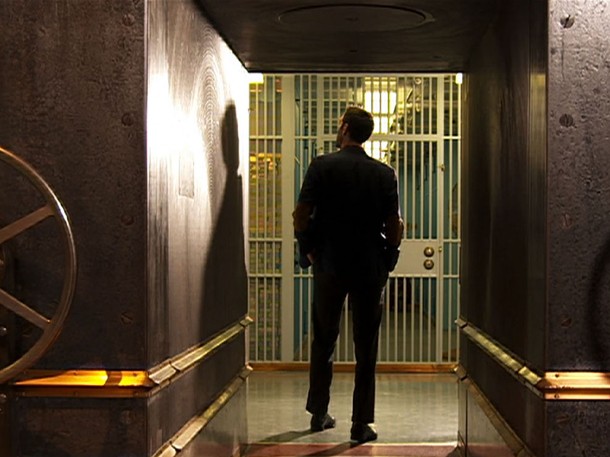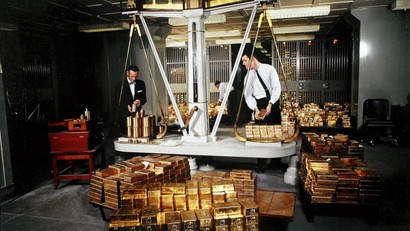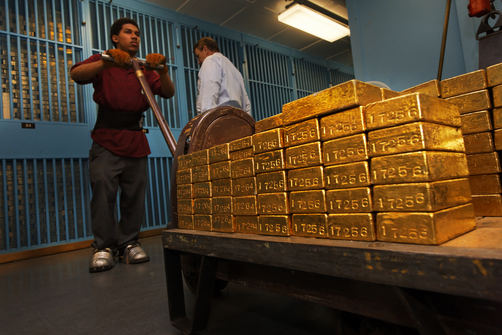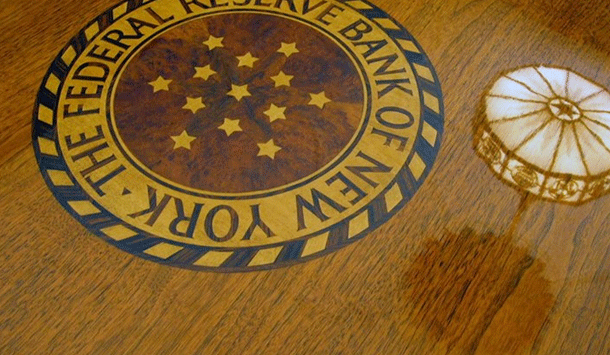The Keys to the Gold Vaults at the New York Fed – Part 1
Over time, the Federal Reserve Bank of New York (FRBNY) has become increasingly less transparent in sharing information about its Manhattan gold vaults. I use gold vaults in the plural because there are two gold vaults at the New York Fed’s headquarters, namely, the main vault and the auxiliary vault.
During the 1970s, New York Fed financial writer Charles Parnow wrote some informative and revealing material profiling the Fed’s Manhattan gold storage arrangements, however, the original text from these publications has been gradually rewritten, distilled, and watered down over time, and today hardly anything of substance about the Fed’s gold vaults makes it on to the New York Fed’s web site.
Luckily, most of this older information is still available from various on-line sources including a number of versions of an FRBNY publication titled ‘Key to the Gold Vault’, and another publication called ‘A Day at the Fed’. Old newspaper articles provide additional coverage.
Although most of the information in the Fed’s brochures has been covered elsewhere and is fairly well-known, there are a number of important and mostly forgotten facts from the early editions of these brochures which I think make an analysis of this material worthwhile. These facts centre on the following:
a) The FRBNY’s Auxiliary vault and its probable location
b) The arrival of low-grade Coin Bars at the FRB in New York in 1968
c) The substantial withdrawals of gold from New York from 1991 to the present day
d) The noticeable decline since the late 1970s in the number of central banks with gold holdings at the FRBNY
Chink of Light?
In October 2010 the Financial Times touched upon a small part of the FRBNY’s gold operations in an article titled ‘Chink of light shed on New York Fed gold’. The article, written by the FT’s Jack Farchy, reported that the FRBNY had revised down from 60 to 36 the number of foreign central bank customers that it claimed to hold gold on behalf of.
According to the FT, this change shed “a rare chink of light on the opaque activities of central banks in the gold market.”
The New York Fed was prompted to explain its gold customer revision after the FT had asked the FRB why a 2004 version of its ‘Key to the Gold Vault’ brochure claimed to hold gold for 60 foreign central banks while the 2008 version of the same publication cited the figure of 36 central banks.
The Fed’s explanation to the FT was that “the revision was the result of a change in the way it counts the countries that use its services to store gold” and that “its previous claim of approximately 60 countries referred to the number of foreign central banks with accounts at the NY Fed, including those that did not hold any gold.”
From 60 to 36 gold customers?
However, as we shall see below, the 2004 publication (and a 1998 version) explicitly referred to “Bullion at the Federal Reserve Bank of New York belonging to some 60 foreign central banks and international monetary organizations”, so this Fed explanation to the FT contradicts what it actually stated in its own publications in 2004 and 1998.
Adding to the confusion, the Fed spokesperson also told the FT (in 2010) that “there has been no change in the number of accounts with active gold holdings in recent years.”
Since gold at the Fed is supposed to be held solely under earmark via distinct bar holdings and weight lists (i.e. not fungible), it’s unclear as to what the Fed meant by ‘active gold holdings’.
The Financial Times also pointed out that after they had contacted the NY Fed in October 2010, “the central bank removed the old (2004) brochure (pdf) from its website.”
The Fed seems to have a penchant for removing gold information from its web site, because in late 2012, the 2008 version of the ‘Key to the Gold Vault’, which used to be here, was also removed from the NY Fed web site, and replaced by the FRBNY’s current rather sketchy gold vault information offering which can be found on its web site here. Interestingly, late 2012 was when the Deutsche Bundesbank first announced that it planned to repatriate some of its gold holdings from the New York Fed.
The current gold information on the FRB´s website merely consists of a spartan one page summary of text from previous versions of the ‘Key to the Gold Vault’, but in my view, most of the important information has been omitted.
Wayback
While the FT thought that the two ‘Key to the Gold Vault’ brochures, dated 2004 and 2008, were “the only known information about the vault”, this is not the case. In total I sourced four versions of this document on the web in addition to a lot of other relevant information.
Both the 2008 and 2004 versions of the ‘Key to the Gold Vault’, as well as a 1998 version, are available to download from old imprints of the Fed’s web site using the Internet Archive (or WayBack Machine). There is also a 1991 version of the document available elsewhere on the web.
The 1991 version contains far more details about the New York gold than the subsequent versions in 1998, 2004 and 2008, and reading through the versions, you can see that nearly everything in the later editions seems to have been replicated from the 1991 version.
You can see all four on-line versions as follows:
Key to the Gold Vault, 2008 version
Key to the Gold Vault, 2004 version
Key to the Gold Vault, 1998 version
Key to the Gold Vault, 1991 version
A limited extract from the 1991 version of ‘Key to the Gold Vault’ is also featured on the Minneapolis Fed web site, here.
There is also another revealing FRBNY publication called ‘A Day at the Fed’ which is relevant to the Fed’s gold vaults. Unfortunately, the ‘A Day at the Fed’ document does not appear to be available on-line any longer and is not accessible via the Wayback Machine. There is a copy of the ‘A Day at the Fed’ uploaded here – A Day at the Fed – Charles Parnow.
Charles Parnow
The 1991 version of ‘Key to the Gold Vault’ was itself based on far earlier versions of the brochure going all the way back to 1973, so some of these forgotten details about the gold go back over 40 years, to an era in which the NY Fed seemed to be, for whatever reason, less secretive.
According to Worldcat, the global library cataloging web site, the ‘Key to the Gold Vault’ was originally authored by Charles J Parnow, with the first edition published by the FRBNY in 1973. Additionally, the ‘A Day at the Fed’ booklet was also authored by Charles Parnow in 1973. Many of the subsequent versions of these documents just appear to have been reprints and reissues, with small rewrites, and then gradually, large chunks of the material were edited out over time.
Both of these publications have also been widely drawn on by journalists over the years when writing newspaper and on-line articles about the Fed’s New York gold vault(s).
Here are the various WorldCat entries for ‘Key to the Gold Vault’ and the ‘A Day at the Fed’
“Key to the Gold Vault”: Federal Reserve Bank of New York: 1973, 1989, 1991, 1998, 2006
“A Day at the Fed”: 1973, 1974, 1977, 1980, 1983
The version of ‘A Day at the Fed’ that I found is from 1997 (by Charles Parnow), but this appears to be just a reprint of an earlier version.
So who was Charles Parnow? From his obituary in 2010:
“After graduating from NYU with a B.S. degree in journalism and finance, Mr. Parnow’s career in writing began as a financial writer for United Press International (UPI). He subsequently held positions at the Federal Reserve Bank of New York where he composed print and multimedia educational material for both adults and children, and was the editor of the company magazine. Before retiring Charles was a senior writer of public information for the New York Stock Exchange. Mr. Parnow was a member of the New York Financial Writer’s Association and the Overseas Press Club."
Charles Parnow was therefore an insider at the New York Fed and everything that he wrote for publication would have been well researched and based on fact. Parnow also appears to have been a well-regarded author on financial matters, and is probably familiar to financially savvy New Yorkers of a certain age. His accomplished writing style comes across while reading the earlier versions of the Fed material.
It’s unclear as to what input if any Parnow would have had after writing the original versions of the publications in the early 1970s. Its also unclear how long Parnow stayed working at the FRB. It would appear that other Fed media staff just re-edited his publications over the years as they saw fit.
Central banks pull back their holdings back from the NY Fed
While the 1991 version to the key to gold vault does not state the number of central bank customers that the FRB holds gold on behalf of, the 1998, 2004 and 2008 versions do, as follows:
“Bullion at the Federal Reserve Bank of New York — the world’s largest repository of gold — belongs to some 60 foreign central banks and international monetary organizations.” (page 5, 1998)
“Bullion at the Federal Reserve Bank of New York belonging to some 60 foreign central banks and international monetary organizations is stored in 122 separate compartments in the main and auxiliary vaults.” (page 5, 2004)
“Bullion at the Federal Reserve Bank of New York belonging to some 36 foreign governments, central banks and official international organizations is stored in 122 separate compartments in the main and auxiliary vaults.” (page 5, 2008)
Notice the reference to the Auxiliary vault in the 2004 and 2008 statements but not the 1998 version.
International Monetary Organizations or Official International Organizations just refers to institutions such as the International Monetary Fund (IMF) and the Bank for International Settlements (BIS).
As you can see from above, the phrase ‘bullion….belonging to some 60 foreign central banks" can’t really have more than one meaning, so the FRBNY’s explanation to the FT in 2010 about the sharp drop in the number of gold customers between 2004 and 2008 makes little sense, i.e. that the “previous claim of approximately 60 countries referred to the number of foreign central banks with accounts at the NY Fed, including those that did not hold any gold”,
The Fed’s explanation makes absolutely no sense at all in light of the fact that this 60 customer figure of gold holders was also quoted by the Fed in 1998, six years prior to 2004, and has been quoted extensively by newspapers and other media from 2004 onwards without the Fed attempting to correct or clarify the total.
For example, in January 2005, in an article about a rare 1933 double eagle $20 gold piece being stored at the FRB’s main gold vault, the New York Times wrote:
“Until last week, the world’s most expensive coin was hidden in the world’s most valuable gold vault. That is to say, in the brilliantly lighted blue-and-white stronghold of E Level, the deepest sanctuary of the Federal Reserve Bank of New York, the city’s bank of banks.
The coin was locked in a compartment at bedrock, 80 feet below Liberty Street in Lower Manhattan, surrounded by $90 billion worth of gold bars — some 550,000 of them — from 60 foreign institutions.”
In November 2006, the American Museum of Natural History wrote on its web site:
“The Federal Reserve Bank of New York holds the world’s largest accumulation of monetary gold. Only a small portion belongs to the U.S. government. The bank serves as guardian for it, as well as the gold monetary reserves of approximately 60 foreign governments, central banks and international organizations.”
Perhaps the 2004 reference to 60 foreign central banks was copied from the 1998 version of Key to the Gold Vault. In that case, the 60 gold customer total would have been correct as of 1998 but not in 2004.
This would suggest that the large decline in central bank customer gold holders took place prior to 2004, some of it most likely due to gold being withdraw for central bank sales and leasing activities, and some possibly after the September 11, 2001 Trade Center destruction, which would certainly have made foreign central banks more reluctant to hold gold in down town Manhattan vaults.
So, we can conclude that at least 24 central banks ceased to have gold holdings at the NY Fed between the late 1990s and 2008.
If you go back even further and search on-line newspaper archives, there are also some references in the 1970s to the number of central banks that stored gold at the New York Fed.
For example, this October 1978 article states that “about 85 individual countries are represented” as gold customers of the FRBNY. You may notice that most of the text in this newspaper article was taken directly from one of the ‘Key to the Gold Vault’ brochures:
A March 1973 article stated that “the (gold) owners are spread among 70 foreign central banks, government agencies, and international monetary agencies”.
This December 1960 article states “the bank stores for free the gold of 72 foreign governments, central banks, and international agencies.” It also says there were 96 cages (not 122 cages), some of which were sub-divided into smaller units.
This July 1963 article also mentions 96 compartments (not 122) and holdings of a massive 13,000 tonnes:
“13,000 tonnes in the vault on level E, with 960,000 bars stored in 96 compartments and owned by 70 foreign governments.”
So, from about 70 countries in the 1960s and early 1970s, the number of countries holding gold at the Fed seems to have peaked at around 85 in the late 1970s before dropping to a range near 60 in the 1990s, and then 36 in 2008. Notice the huge decline of ~50 gold account holders between 1978 and 2008.
The rise customer numbers in 1978 was no doubt partially due to some central banks opening up gold accounts at the Fed in order to receive restituted gold from the IMF during the gold restitutions around that time.
Remembering that the US Treasury also holds about 5% of its supposed gold reserves at the FRBNY, then, as of 2008 there were 36 foreign central banks and the US Treasury (i.e. 37 institutions) holding gold reserves at the FRBNY.
Surprisingly, the US Treasury in its gold custodial inventory of gold held at the FRBNY lists claims that it holds 31,204 bars in 11 compartments, but the schedule lists these 11 compartments as letters from A to K, and not numbers as are written on the compartments/cages in the FRBNY main vault.
The US Treasury gold supposedly stored at the FRBNY is listed here, starting on page 132 of the pdf (or page 128 of file).
Millions of Ozs in the Vaults
Since the early 1970s there has been a consistent drop in the amount of gold held by foreign account holders at the NY fed. Some quotes follow:
“(The vault) contained approximately 315 million troy ounces of gold early in 1991, comprising approximately 28 percent of the world’s official monetary gold reserves.” (Introduction, Key to the Gold Vault (KTTGV) 1991)
“In 1997, the New York Fed held about 275 million troy ounces of gold, or 8,600 tons, worth approximately $12 billion at the official U.S. Government price ($42.22 per fine troy ounce)” (A Day at the Fed 1997)
“In the middle of 1997, the Fed’s vault contained roughly 269 million troy ounces of gold.” (page 6, KTTGV 1998).
“In mid – 2004, the Fed’s vault contained roughly 266 (226) million troy ounces of gold”. (page 6, 2004 KTTGV)
Note:The 266 million ounces was a typo in the 2004 brochure, and they meant to write 226 million ounces because they quoted a valuation of $90 billion based on a price of $400 per ounce. See explanation below.
“As of early 2008, the Fed’s vault contained roughly 216 million troy ounces of gold.” (page 6, KTGV 2008).
“As of 2012, the vault housed approximately 530,000 gold bars, with a combined weight of approximately 6,700 tons” Current NY Fed gold page on web site. This would be 212 million troy ounces if all the bars were 400oz good delivery bars (of 995 fineness or above).
Note: The NY Fed also used their 2010 update to the Financial Times to state that whereas their 2004 brochure claimed that they held 266 million ounces of gold on behalf of central bank customers, this should in fact have said 226 million ounces. This discrepancy is definitely just a typo since the same sentence in the brochure quoted a total gold holding value of $90 billion at $400 per ounce, which equates to 225 million ounces..
So, gold holdings at the FRBNY fell from 316 million ounces in 1991, to between 269 – 275 million in 1998, to 226 million in 2004, and 216 million in 2008, and 212 million in the last few years. That’s a 100 million ounce drop from 1991 to 2008 , or 3110 tonnes.
That this 100 million ounce outflow of gold from the Fed´s New York vaults took place in conjunction with a marked decline in the number of foreign central bank gold account holders at the Fed, suggests that some of the customers withdrew all of their New York gold holdings and ceased to be gold customers.
Part 2 of The Keys to the Gold Vaults at the New York Fed will focus on the FRB´s rarely talked about Auxiliary Vault, while Part 3 will shed some light on ‘coin bars’ and look at why coin bars arrived at the Fed’s Manhattan vaults, and where they might have gone since then.
Popular Blog Posts by Ronan Manly
 How Many Silver Bars Are in the LBMA's London Vaults?
How Many Silver Bars Are in the LBMA's London Vaults?
 ECB Gold Stored in 5 Locations, Won't Disclose Gold Bar List
ECB Gold Stored in 5 Locations, Won't Disclose Gold Bar List
 German Government Escalates War On Gold
German Government Escalates War On Gold
 Polish Central Bank Airlifts 8,000 Gold Bars From London
Polish Central Bank Airlifts 8,000 Gold Bars From London
 Quantum Leap as ABN AMRO Questions Gold Price Discovery
Quantum Leap as ABN AMRO Questions Gold Price Discovery
 How Militaries Use Gold Coins as Emergency Money
How Militaries Use Gold Coins as Emergency Money
 JP Morgan's Nowak Charged With Rigging Precious Metals
JP Morgan's Nowak Charged With Rigging Precious Metals
 Hungary Announces 10-Fold Jump in Gold Reserves
Hungary Announces 10-Fold Jump in Gold Reserves
 Planned in Advance by Central Banks: a 2020 System Reset
Planned in Advance by Central Banks: a 2020 System Reset
 Zimbabwe’s new gold-backed currency: Can the ZiG restore confidence and stability?
Zimbabwe’s new gold-backed currency: Can the ZiG restore confidence and stability?




 Ronan Manly
Ronan Manly 10 Comments
10 Comments














